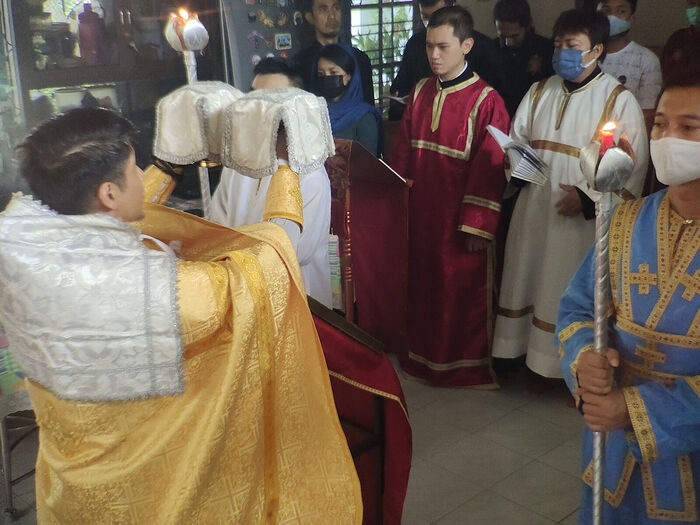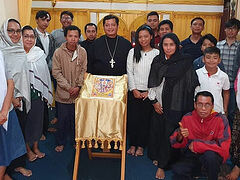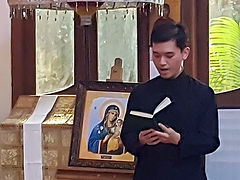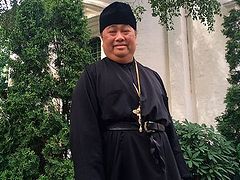 Geraldio Lau Gefaldo It is Saturday. The large house on Kartajaya Street in the Indonesian city of Surabaya on Java is crowded. Everyone has gathered in the kitchen, the easternmost part of the building. Within a few hours the dining-room will temporarily turn into the holy of holies of every Orthodox church: the altar/sanctuary. The priest carefully sets up a special table, covers it with an endytion, lays an antimension and the Gospel on top, puts a wooden cross on it, and lights candles. To the left of the Gospel is an icon of the Mother of God, to the right is an icon of the Savior. This is the main part of the sanctuary: the holy altar table. A twenty-year-old acolyte named Sergius Gefaldo assists the priest. He prepares the censer, folds the liturgical vestments, and wipes the icons. Here, in a few hours, they will be celebrating the Radiant Resurrection of Christ!
Geraldio Lau Gefaldo It is Saturday. The large house on Kartajaya Street in the Indonesian city of Surabaya on Java is crowded. Everyone has gathered in the kitchen, the easternmost part of the building. Within a few hours the dining-room will temporarily turn into the holy of holies of every Orthodox church: the altar/sanctuary. The priest carefully sets up a special table, covers it with an endytion, lays an antimension and the Gospel on top, puts a wooden cross on it, and lights candles. To the left of the Gospel is an icon of the Mother of God, to the right is an icon of the Savior. This is the main part of the sanctuary: the holy altar table. A twenty-year-old acolyte named Sergius Gefaldo assists the priest. He prepares the censer, folds the liturgical vestments, and wipes the icons. Here, in a few hours, they will be celebrating the Radiant Resurrection of Christ!
Geraldio Lau Gefaldo was born and raised in the city of Surabaya, Indonesia, in a Protestant family. At the age of sixteen he was Baptized in Orthodoxy with the name Sergius, in honor of St. Sergius of Radonezh. For him Orthodoxy became the final point in his spiritual quest. As a schoolboy, he called himself an occultist, a Buddhist, a Hindu...
Now Sergius Gefaldo is twenty years old, and he is an acolyte at the house Church of St. Jonah of Manchuria, Bishop of Hankou, in the Indonesian city of Surabaya. His story is about how Orthodox Indonesians celebrate the most important Christian feast: the Resurrection of Christ.
The modern Orthodox mission in the city of Surabaya began in 2007. This port city is located on the east coast of Java. It is an important economic center; more than three million people live here. The population is predominantly Muslim (ninety percent); the rest are Catholics, Protestants, Buddhists, and Hindus. It is very difficult to build an Orthodox church in our country. First, land is expensive. Second, you need to collect plenty of documents and get the signatures of at least sixty people living in the area, which is unrealistic. Therefore, all the Orthodox churches are house churches, and unfortunately, few people know about them.
The parish of St. Jonah of Manchuria is the only Orthodox parish in the city of Surabaya. And these days we are going through hard times. Previously, services were celebrated in a house church: It was located in a large room, which was provided for free use by one of our parishioners. There we had everything an Orthodox church needs: an iconostasis, a sanctuary, the Royal Doors, an ambo, a choir, a solea, and a large space for parishioners. Unfortunately, the pandemic has affected our lives, and last April we had to move out. The church rector, Fr. Kirill, offered his house for services. Now our community gathers only once a week for the Sunday Liturgy. And each time we make a church out of the dining room: first we tidy the room thoroughly, wash the floor, dust, and take out everything unnecessary. Then we assemble the holy altar table, and place the icons and candles on it. In the center of the sanctuary we place the altar table: a quadrangular table, consecrated and covered with an endytion. Fr. Kirill always assembles the altar table himself. This is the most sacred place in every church, a place of the special presence of Divine Glory.
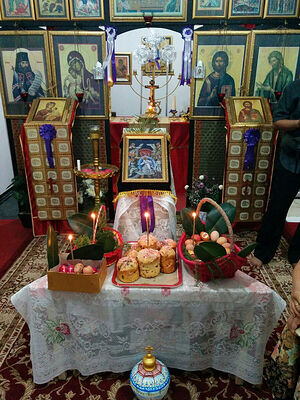 This year we began preparations for the festal Paschal service on Saturday morning. When there was no trace of the kitchen left (except for a refrigerator in the far corner), we vested ourselves. The priest uttered an exclamation, which marked the beginning of the service. There were a lot of people—thirty of us—and about half were catechumens. These are young people—students and those who have just graduated from universities. It is customary in our parish that those who have recently come to church undergo catechesis for a year, actively attend services, and only then get baptized.
This year we began preparations for the festal Paschal service on Saturday morning. When there was no trace of the kitchen left (except for a refrigerator in the far corner), we vested ourselves. The priest uttered an exclamation, which marked the beginning of the service. There were a lot of people—thirty of us—and about half were catechumens. These are young people—students and those who have just graduated from universities. It is customary in our parish that those who have recently come to church undergo catechesis for a year, actively attend services, and only then get baptized.
During the Paschal service, we cannot have a full-fledged religious procession since we are not allowed to attract the attention of other people in the street. Therefore, we symbolically and solemnly walk in a circle in the room. Unfortunately, we don’t sing the Paschal Canon either. We still don’t have an Indonesian translation of it.
We sing the Paschal Troparion three times: in Indonesian, Church Slavonic and Greek. We also have a Javanese version. There are many dialects in Indonesia: the official language is Indonesian, but on the island of Madura they speak the Madurese language, on Bali—Balinese, in Jakarta—Betawi, in Banten (the westernmost province of Java)—Sundanese. Javanese is spoken in the eastern part of the island where we live. We sang the Paschal Troparion in Javanese for the first time this year. I prepared in advance: I found the text on the Internet, translated it, printed out the sheet music and showed it to everyone. And our choir is our parishioners. We read the Gospel in seven languages: Indonesian, Javanese, Church Slavonic, Greek, Latin, French and Dutch.
Our parishioners wear festive clothes for Pascha—men always wear batik shirts. Batik is a hand-painted fabric with special paints and compositions. In Indonesian “batik” literally means “a drop of wax”. This is a special painting technique that was invented by the Indonesians. In 2009, batik was added to UNESCO’s Intangible Cultural Heritage of Humanity list.
Women very rarely wear dresses and skirts, even when they go to church. Most often their clothes are a shirt or blouse made of batik and trousers, and a scarf on their head.
We also have a tradition of dyeing eggs for Pascha. We use two colors: red and green, or just leave them white. We draw a cross and write “XB” (an abbreviation for “Christ is Risen” in Church Slavonic). And we also bake Easter cakes. We have all the ingredients needed here in Indonesia.
Pascha is an opportunity for people to gather together. At Pascha there comes a feeling of quiet peace, which the joy of the Radiant Resurrection of Christ brings us!
After the Paschal Liturgy of St. John Chrysostom we gather for a meal. This year was no exception. We agreed in advance on which food each of us would bring. We have a Javanese proverb, “If we don’t eat rice, then we don’t eat anything at all.” We use rice with all dishes, and we love fish and mutton kebabs.
Compared to churches in Russia, our services are still incomplete here. We lack Indonesian translations of the texts. For me the most difficult thing in Orthodoxy is living in a non-Orthodox country. There are six recognized religions in Indonesia: Islam, Protestantism, Catholicism, Hinduism, Buddhism and Confucianism. I believe that if we have a large church in Surabaya, the number of the faithful will grow rapidly. Then Orthodoxy will become an official religion. I really want that!

